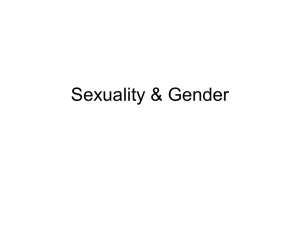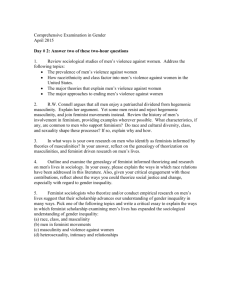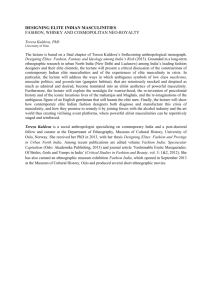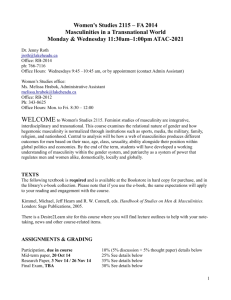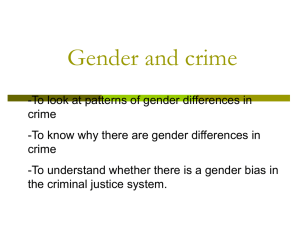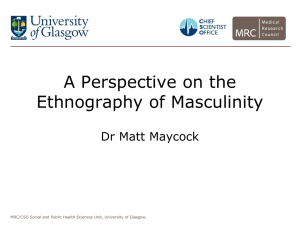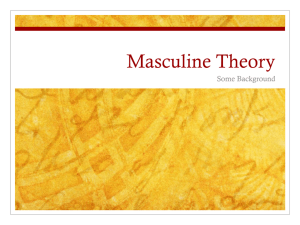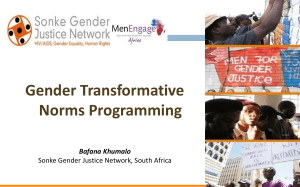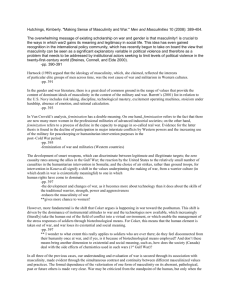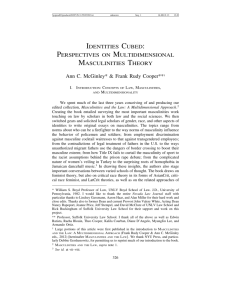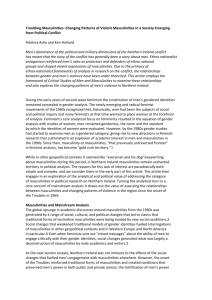Background_Note_on_Curricula-Final
advertisement
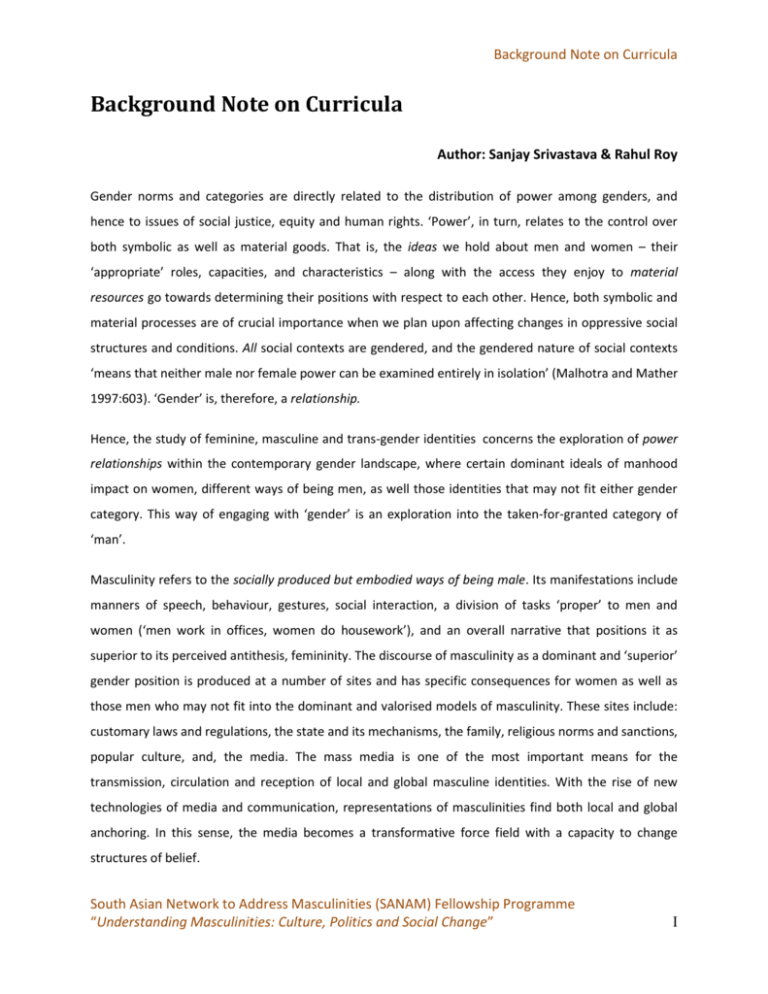
Background Note on Curricula Background Note on Curricula Author: Sanjay Srivastava & Rahul Roy Gender norms and categories are directly related to the distribution of power among genders, and hence to issues of social justice, equity and human rights. ‘Power’, in turn, relates to the control over both symbolic as well as material goods. That is, the ideas we hold about men and women – their ‘appropriate’ roles, capacities, and characteristics – along with the access they enjoy to material resources go towards determining their positions with respect to each other. Hence, both symbolic and material processes are of crucial importance when we plan upon affecting changes in oppressive social structures and conditions. All social contexts are gendered, and the gendered nature of social contexts ‘means that neither male nor female power can be examined entirely in isolation’ (Malhotra and Mather 1997:603). ‘Gender’ is, therefore, a relationship. Hence, the study of feminine, masculine and trans-gender identities concerns the exploration of power relationships within the contemporary gender landscape, where certain dominant ideals of manhood impact on women, different ways of being men, as well those identities that may not fit either gender category. This way of engaging with ‘gender’ is an exploration into the taken-for-granted category of ‘man’. Masculinity refers to the socially produced but embodied ways of being male. Its manifestations include manners of speech, behaviour, gestures, social interaction, a division of tasks ‘proper’ to men and women (‘men work in offices, women do housework’), and an overall narrative that positions it as superior to its perceived antithesis, femininity. The discourse of masculinity as a dominant and ‘superior’ gender position is produced at a number of sites and has specific consequences for women as well as those men who may not fit into the dominant and valorised models of masculinity. These sites include: customary laws and regulations, the state and its mechanisms, the family, religious norms and sanctions, popular culture, and, the media. The mass media is one of the most important means for the transmission, circulation and reception of local and global masculine identities. With the rise of new technologies of media and communication, representations of masculinities find both local and global anchoring. In this sense, the media becomes a transformative force field with a capacity to change structures of belief. South Asian Network to Address Masculinities (SANAM) Fellowship Programme “Understanding Masculinities: Culture, Politics and Social Change” I Background Note on Curricula In order to stand in a relationship of superiority to feminine identity, masculinity must be represented as possessing characteristics that are the binary opposite of (actual or imagined) feminine identity. However, this is not all. Dominant masculinity stands in a relationship not just to femininity but also to those ways of being male that are seen to deviate from the ideal. It is in this sense that masculinity possesses both external (relating to women) as well as an internal (relating to ‘other’ men) characteristics. It is also for this reason that we speak of masculinities rather than masculinity (in the singular). There is also the need to differentiate the linked ideas of ‘patriarchy’ and ‘masculinity’. Patriarchy refers to a system of social organization which is fundamentally organised around the idea of men’s superiority to women. Within this system, even those who may not approximate to the male ideal (such as homosexual men) still stand to benefit from the privileges attached to being a man. So, as a parallel, we might think of the situation on apartheid era South Africa where all whites – those who supported apartheid and those who opposed it – were potential beneficiaries of the institutionalised privileges of being white. Though it is difficult to posit simple definitions of ‘patriarchy’ and ‘masculinity’, we might say that patriarchy refers to the systemic relationship of power between men and women, whereas masculinity concerns both inter and intra-gender relationships. And, while it can not be argued that under patriarchy all forms of masculinity are equally valorised, there is nevertheless an overwhelming consensus regarding the superiority of men over women. Patriarchy ‘makes’ men superior, whereas masculinity is the process of producing superior men. The ideas of ‘making’ and ‘producing’ are crucial to the study of gender identities, for they point to their historical and social nature. The gigantic archive of ‘proper’ masculine behaviour – in novels, films, advertisements, and folk-advice – would clearly be unnecessary if it was a naturally endowed characteristic. The very fact that masculinity must consistently be reinforced – ‘if you buy this motorcycle you’ll be a real man’ – says something about the tenuous and fragile nature of gender identities; they must continually be reinforced. Following from this, we might also say that masculinity is enacted rather than expressed. For, when we say that something is ‘expressed’, we are working with the idea that it ‘already exists’, and gender identities in particular do not already exist (say, biologically). There is an entire task of building and rebuilding, consolidation, representation, and enforcement; in other words we must think of gender identities as works in progress. South Asian Network to Address Masculinities (SANAM) Fellowship Programme “Understanding Masculinities: Culture, Politics and Social Change” II Background Note on Curricula A crucial task of this course is to foreground the social nature of gender identities and simultaneously explore possibilities of interventions. When we speak of ‘gender’, we are speaking of social and cultural attributes within human society. This approach moves away from the biologism that has historically been part of the study of gender and sexual identities. Biologism is the thinking that suggests that gender and sexual identities: are biologically derived have been historically stable (i.e. the same since the ‘dawn of time’) are ‘essentially’ about our ‘private’ lives, and, are ‘basically’ the same across different cultures are normative. To imagine identities and behaviours as socially and historically constituted is also to imagine the possibility of effecting change in a desired direction. For, if masculine identities vary across time and space – appear in different forms at different times and are different across societies – therein lies the possibility of formulating appropriate policy measures and programmes and projects to influence the contexts within which gender inequalities persist. Globalisation, Development and Masculinities Globalisation has been understood in different ways. However, most people agree that it is about living in a more interconnected world with a definite economic, social and cultural process. Economically it is referred to as the reduction and removal of barriers between national borders in order to facilitate the flow of goods, capital, services and labour. Socially and culturally it connects us through the availability of goods, food, entertainment and information that are produced in any part of the globe to be consumed in any other. Even local work and jobs are dependent on the shifts in the global economy. In this scenario relations between men and women are rapidly changing and gender relations are being redefined. This section will build an understanding of how global processes have a bearing on individuals, families and communities living in different parts of south Asia. South Asian Network to Address Masculinities (SANAM) Fellowship Programme “Understanding Masculinities: Culture, Politics and Social Change” III Background Note on Curricula Customs, Religion and Masculinities The formation of identities through religion and cultures of masculinity is a prevalent feature of the region. Religious solidarities are often mobilized through appeals to a shared masculinity. The public expression of religious symbols is the background against which political formations take shape. The manner of expression of these symbols privileges the issue of gender by linking it to the gendering of the nation, i.e. how national identity and gender become linked contexts. Contemporary religiosity, whose contours are more mobile and unpredictable than before, has revealed itself to be one of the most decisive factors in the constitution of all cultural identity. The one element that this religiosity shows is the crucial importance of congregations in maintaining itself and disseminating its message. Almost all these congregations (mainly communities of men) are tied together by ideas of sacrifice, martyrdom, altruistic suicide. A focus on the making of congregations helps us understand how masculine identities might be constructed through ideas of socio-cultural differences, and how cultural differences inhibit the processes of socio-cultural integration. The nostalgia for a culturally homogeneous society, for a strict separation between men and women in the public, for a close and literal reading of canonical texts, affects not only the possibilities of public dissent, but also supplies the normative basis of cultural separatism. The move towards homogeneity is made through the vehicle of religious symbols and it becomes important to investigate the scope of such symbols. A recurrent feature of south Asian cultures is the expression of ethno-nationalism based on the forging of a homogeneous cultural identity. Expressions of ethnic nationalism and linguistic identities are also accompanied with a pervasive collective violence and the cult of charisma. Without exception, the leadership of such movements draws its inspiration from an appeal to a mythic past based on masculinised cultures. The region offers a variety of ethnic movements informed by a series of primordial loyalties. While ethnic movements seem at odds with the secular consensus of modern states, they also force us to acknowledge that membership to a group can be premised upon an adherence to customary law. Across Asia, the resurfacing of customs that were thought to have been superseded by civil law shows the resilient character of local traditions. Whatever the cultural contents and variations of such customs, the one common factor that they express is that of restrictions to be placed upon women and the role South Asian Network to Address Masculinities (SANAM) Fellowship Programme “Understanding Masculinities: Culture, Politics and Social Change” IV Background Note on Curricula of men as arbiters. The asymmetrical effect of such custom upon men and women needs to be mapped, especially its authorizing of gender based violence. One of the main justifications of male violence against women is the ‘cultural rights’ argument, variously posed in the idiom of honour, shame, and the maintenance of solidarity networks. In some societies in Asia, cultural rights have been enshrined as ‘customary’ law, while in others, honour and shame have been replaced by civil procedures of restitution. To trace the complexities of ethnic violence and its persistence over time, a comparative understanding of the custom of ethnic group solidarity would be of invaluable help in delineating cultures of violence. Media and Masculinities Mass media is perhaps the most important means for the transmission, circulation and reception of local and global gender identities. With the rise of new technologies of media and communications, representations of gender – feminine, masculine and ones that don’t fit this binary – come to be represented in complex ways. Further, media representations of gender are one of the most significant ways in which social and cultural norms regarding gender are both circulated as well as transformed. Irrespective of the regional context, globalization as a backdrop is fundamental to the ways in which contemporary gender identities are produced and negotiated. However, though new forms of media – satellite television and the internet, for example, – play an active role in circulating representations of masculinities, these also draw upon longer cultural histories, memories, and experiences. The sheer pervasiveness of the media as a purveyor of information and entertainment makes it imperative to understand the ways in which it constructs representations of gender, as well as how these intersect with contexts such as class, religion, caste and ethnicity. Institutions and Masculinities The idea that the public sphere is a ‘masculinised’ one is the starting point for exploring the relationship between gender and the functioning and structure of institutions. Here, the kinds of questions we need to explore include: How is gender power consolidated through civic associations such as clubs and societies that, either implicitly or explicitly, base themselves upon masculinist ideologies? How are the conjoined contexts of patriarchal privilege and masculinist ideals normalized through public institutions such as state bureaucracies, schools, the legal system and the police? The historic division of social life South Asian Network to Address Masculinities (SANAM) Fellowship Programme “Understanding Masculinities: Culture, Politics and Social Change” V Background Note on Curricula as ‘public’ and ‘private’ has simultaneously entailed a division of institution as public and private. And, along with this, there has developed logic of – what might be called – the gender of such institutions. Hence, according to this logic, public institutions have been understood to be the ‘natural’ preserve of men and hence have tended to operate according to a variety of masculinist ideologies. One example of this is that the media quite often provides accounts of public women through describing what they wear, or, how many children they have. Beyond this, there are even more serious issues, such as the denial of equal opportunities to women through masculinity notions of what men can do and what women are capable. It becomes important, therefore, to explore the gender of our institutions in order to devise strategies if change. Patriarchy, Masculinity and Sexuality While patriarchy socially embeds the disprivileging of women as a group, masculinity is the process by which the hierarchy of gender orders is maintained. Amongst other things masculinities has often been described as a policing mechanism that maintains social hierarchies not only between women and men but also between men on the basis of class, caste, culture, religion, sexuality, etc. Since masculinity is not simply a biological state but an unstable process and a state that has to constantly striven towards, it is inherently unstable. This instability means that men have to constantly prove their manhood in various social spheres including their sexual lives. Performance therefore becomes the cornerstone of men’s sexual practices and yet another arena that men have to negotiate within the context of experiencing power. In this section we will explore the determinants of men’s experiences of sexuality and the linkages between intimacy, love, sexuality, performance and power. The section will also explore the modes by which codes of sexual control are established and practiced in different institutional settings and the consequences of such practices on relations between men and women and between men. South Asian Network to Address Masculinities (SANAM) Fellowship Programme “Understanding Masculinities: Culture, Politics and Social Change” VI Background Note on Curricula Self and Gender The invisibility of gender to men and their inability to look at themselves as gendered remains the biggest challenge in creating spaces of self reflection that could contribute to challenging dominant forms and practices of masculinities. This section will provide for self exploratory methods of identifying the role and practice of gender in men’s lives. The emphasis would be on delineating the process by which a certain ‘normativity’ is generated around the experience and practice of masculinities by identifying it as a core or essence of being men as opposed to gender being a relational reflection of the relations between men and women. Conflict and Violence Masculinities can be understood in various ways but one element that remains common to most definitions is its relationship with power. The experience of masculinities is about an entitlement to power. An entitlement that may not translate into an actual experience of power in all situations because our social fabric is a pyramid constructed on class, caste, religious, geographical, ethnic, cultural, sexual and segregation but nevertheless the sense of entitlement is what marks most expressions of masculinities from inside homes to institutions outside. And no doubt this tension between a sense of entitlement and in many cases an experience of powerlessness is a contributory factor to many conflicts that men find themselves caught within. This section will explore the linkages between conflict, masculinities and violence in different social and political settings from within families to its manifestation in communal, ethnic and nationalist expressions. Skills Building At the heart of this project is to design a curriculum that works through the triad of epistemology, pedagogy and cognition to generate critical knowledge that can be utilized by South Asian Network to Address Masculinities (SANAM) Fellowship Programme “Understanding Masculinities: Culture, Politics and Social Change” VII Background Note on Curricula fellows to build grass root interventions that effectively address masculinities and gender based violence. The roots of knowledge around gender, the implication of translating this knowledge into training and curricula that gives primacy to processes of learning rather than prescriptive models of change are the central concerns that will facilitate both the design of the curricula and the training methodologies. There exists in South Asia a pool of knowledge and skill that has been generated through several years of application in community situation. It is the aim of this project to collate the learning from these interventions and transfer it into a curriculum that generates knowledge not only towards a better understanding of the various ways in which masculinities operates and affects community lives but also provides the skill to negotiate these situations with effective programming. The curricula will set out a skill imparting section that will acquaint the participants with ongoing interventions, strategies and tools that are being utilized. However, importance will be given to critically reflect on these and develop appropriate strategies for each location where the fellows will intervene rather than blindly adopt methods that have been followed by others. South Asian Network to Address Masculinities (SANAM) Fellowship Programme “Understanding Masculinities: Culture, Politics and Social Change” VIII
